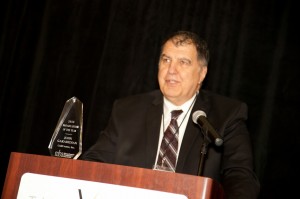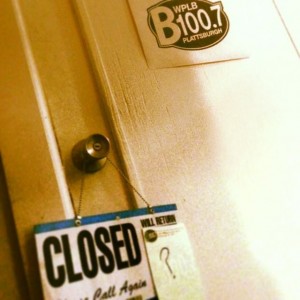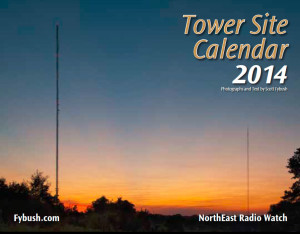NorthEast Radio Watch 12/8/2025: Cichon’s Back in Buffalo
In this week’s issue… Veteran newsman returns - Remembering NY's Leitner, RI's Jones - CT AM saved - Maine AM moves - "Indie" adds suburban signals
In this week’s issue… LPFM window yields fewer apps than expected – Geraldo goes local – Quinn out at Pittsburgh’s WPGB, affiliates – Lydon back at WBUR – AM auction includes NY, PA channels
By SCOTT FYBUSH
*How many low-power FM stations will emerge from the filing window that’s just ended at the FCC? That may not be the million-dollar question, given the tiny budgets of many would-be LPFM operators, but it’s at least a question that’s a little easier to answer now that the FCC has released all the applications it received during the window.
 Nationwide, that’s about 2,800 applications, a significantly smaller number than many LPFM gurus were expecting. With the help of our content partners at Radio Insight and The Archives @ BostonRadio.org, we’ve compiled all those applications into a single searchable page that we published over the weekend.
Nationwide, that’s about 2,800 applications, a significantly smaller number than many LPFM gurus were expecting. With the help of our content partners at Radio Insight and The Archives @ BostonRadio.org, we’ve compiled all those applications into a single searchable page that we published over the weekend.
As we go state by state in a special “Extra” edition of NERW coming tomorrow for subscribers only, we’ll pick out some of the more interesting applications and what may be the most contested mutually-exclusive (MX) applications (who knew Providence was poised to be an LPFM hot spot?) . If you’re a licensed FM broadcaster, we urge you to spend a few minutes with the list yourself: quick action now can forestall an issue with LPFM interference later on, and there are certainly some less well-crafted applications in the pile that could cause problems to existing broadcasters.
There’s plenty of debate within the industry now about how many of those 2,800 or so new LPFM applications will ever turn into licensed stations. An initial sweep of the applications in NERW-land shows plenty of applications that should be easily and quickly grantable as “singletons” – but plenty more that will have some issues to overcome.
What’s in the way? There’s that “MX” factor, for one thing – if you’re one of the many broadcasters hoping for a new signal on 94.9 in the Boston area or 101.1 in Providence or 92.9 in Philadelphia, you’re likely headed to a “points” competition in which you’ll have to show that your local board, local programming plans and established local presence outrank your rivals. But that process is still likely to lead to plenty of ties, which get resolved first through voluntary time-shares (and, if that doesn’t materialize, a mandatory short-term license for each applicant, one at a time until they all expire, in a process that’s yet to actually occur in the real LPFM world.)
Then there’s the second-adjacent issue: while the FCC created many new LPFM opportunities in urban areas by loosening the rules on second- and third-adjacent spacing between full-power and low-power signals. But operation on second-adjacent channels like 92.9 in Philadelphia (to WXTU 92.5 and WMMR 93.3) and 101.1 in Providence (to WWBB 101.5) requires a more complicated engineering showing than the usual LPFM application – and it’s not hard to imagine that full-power stations will be paying close scrutiny to the possibility of new neighbors on the dial.
And of course there’s the never-ending question of how to make a 100-watt FM signal viable in the incredibly crowded media landscape of 2013. The religious groups that make up one big chunk of the applicant pool will have no problem with viability; they’ll turn, as they always do, to various satellite networks such as EWTN and Three Angels to provide most of the programming their new LPFMs need. There’s a rather larger pool this time of colleges, school districts and municipalities than we saw in the last LPFM window, and those stations will at least have a reasonable source of funding (if not necessarily volunteer programmers these days). It’s the ad hoc community groups that face the biggest challenges: even if they can pull together the tens of thousands of dollars needed to build out studios and transmitter sites, can they keep up with the day-to-day pressures of maintaining a program schedule and raising ongoing operating funds? It’s not an easy task, and we deeply admire the stations that have managed to do it in LPFM’s first decade.
*The FCC paid some long-delayed attention to the AM band last week, too. It wasn’t just the Federal Register publication of the Commission’s AM improvement proposals, which we’ll address in more detail next week, but also the release of details on AM Auction 84. The first round of bids are now due May 6, 2014 in what the FCC hopes will be the very last chapter of the AM window that it opened way back in 2004. This auction will dispose of the last mutually-exclusive applications from that window, including three groups in NERW-land that we’ll run down as we make our way state by state through the rest of the week’s news…
[private]
*In MASSACHUSETTS, Christopher Lydon has never exactly been “off the air” in the dozen years since he lost his daily slot hosting “The Connection” on WBUR-FM (90.9 Boston), but the veteran broadcaster has had his ups and downs as he’s attempted to stay visible through podcasting and through partnerships with WGBH (89.7) and Lowell’s WUML (91.5). Whatever hard feelings might have remained from Lydon’s 2001 split with then-WBUR GM Jane Christo have apparently healed: last week, WBUR announced that Lydon and his longtime producer Mary McGrath will bring their “Open Source” to the WBUR airwaves once a week beginning in January. The show will air Thursday nights from 9-1o, in a slot now filled by “The Moth Radio Hour”; it will also repeat on the weekends. Lydon’s first stint with WBUR began in 1994 after his former home, WGBH-TV, cancelled the nightly newscast he’d been anchoring.
 Back in Lydon’s first stint at WGBH, most of the station’s news efforts were focused on the TV side of things, but these days the big news push is down the hall at WGBH (89.7), which just added two more news staffers last week. Deb Daigle, who’s worked at WBZ (1030), WRKO (680), Unistar Radio and in Worcester, takes over from Jordan Weinstein as local anchor during “All Things Considered” from 4-7 PM. That moves Weinstein to midday news anchor and former midday anchor Cristina Quinn into a reporting role. WGBH’s other new hire is Rupa Shenoy, who’s working for a new partnership between WGBH and the New England Center for Investigative Reporting, which is now operating out of the WGBH newsroom.
Back in Lydon’s first stint at WGBH, most of the station’s news efforts were focused on the TV side of things, but these days the big news push is down the hall at WGBH (89.7), which just added two more news staffers last week. Deb Daigle, who’s worked at WBZ (1030), WRKO (680), Unistar Radio and in Worcester, takes over from Jordan Weinstein as local anchor during “All Things Considered” from 4-7 PM. That moves Weinstein to midday news anchor and former midday anchor Cristina Quinn into a reporting role. WGBH’s other new hire is Rupa Shenoy, who’s working for a new partnership between WGBH and the New England Center for Investigative Reporting, which is now operating out of the WGBH newsroom.
*Around the corner at Entercom, there’s a search on for a new producer for WAAF (107.3)/WKAF (97.7) morning man Greg Hill. His producer of 14 years, Anthony Parziale (known on air as “Spaz”) is moving on. (Boston Radio Watch reports Parziale’s new venture is a junk-removal business called “TakeJunk.com.”)
*The Massachusetts Broadcasters Association held its “Sound Bites” award night on November 14, and the night’s big winner was veteran station owner and jock John Garabedian, who was honored as Broadcaster of the Year. Garabedian’s career is well known to NERW readers, from his early years on the air at stations such as WORC in Worcester and WMEX in Boston to his construction of WGTR (1060 Natick) and pioneering music-video TV outlet WVJV (Channel 66) to his syndicated “Open House Party” and Superadio network, right up to his current gig at the helm of the Codcomm group on Cape Cod.

Garabedian’s first on-air gig, way back in 1960, was at little WMRC (1490 Milford) – and WMRC had its moment in the MBA spotlight, too, being named Station of the Year.
*At WCVB (Channel 5), they’re mourning longtime video editor Ron Sapp, who died in a boating accident Nov. 16 in Myles Standish State Forest. Sapp, 60, had been canoeing in a pond in the forest. His work at WCVB included a long stint as an editor on “Chronicle.”
And there’s a callsign change for Alex Langer’s newly-relocated AM on Boston’s southern edge. What was WMSX (1410 Brockton), now relocated to a new city of license of Dedham, has taken the WZBR callsign that Langer was parking on his unbuilt 1120 Coral Springs, Florida. The WMSX calls, in turn, are now being parked in Florida. Is a new format announcement coming soon for 1410, which has been testing its new signal from a site in Hyde Park near the Boston city limits?
 *What’s next for NEW YORK‘s WABC (770) once the Cumulus talker loses longtime staple Rush Limbaugh to Clear Channel’s WOR (710) in just over a month? The answer appears to include “more local talk,” in the form of a new local version of Geraldo Rivera’s midmorning show.
*What’s next for NEW YORK‘s WABC (770) once the Cumulus talker loses longtime staple Rush Limbaugh to Clear Channel’s WOR (710) in just over a month? The answer appears to include “more local talk,” in the form of a new local version of Geraldo Rivera’s midmorning show.
Starting in January, Geraldo’s national show will return to its original New York-only status on WABC from 10 AM until noon, which means we’re still waiting for the big announcement about what will fill Limbaugh’s noon-3 timeslot in 2014, bridging the gap between Rivera and Michael Savage’s new 3-6 PM slot.
*The FCC’s AM Auction 84 will include a new signal on AM 1700 in Rockland County, resolving a mutually-exclusive group of four applications filed during a special window the Commission opened in 2007. This is the only piece of Auction 84 that doesn’t involve the 2004 window; instead, these applications were the result of political pressure on the FCC to give Rockland a full-time local AM voice, ostensibly to address public safety concerns from the nearby Indian Point nuclear plant.
The four applicants are S&B Broadcasting (for Stony Point), Talkline Communications (Monsey), Polnet Communications (Haverstraw) and Alexander Broadcasting (Ramapo), which started the process when it applied for an upgrade to its existing WRCR (1300 Spring Valley). Whichever parties are still interested in bidding next May will start with a $10,000 bid for the new signal, which will run 10,000 watts day, 1000 watts at night.
 At the other end of the state, they’ve literally hung out the “we’re closed” sign at WPLB (100.7 Plattsburgh West), where North Country Broadcasting has been leasing the class C2 signal from licensee Westport Radio Partners LLC since the summer of 2012. “B-100.7” was the most recent attempt to make this relatively new signal work (remember “Bistro 100.7”?), but it’s been hampered by technical difficulties, and now the “B” crew says “due to some conditions beyond our control,” they’ve ceased operating. It’s not clear what, if anything, will come next on 100.7…
At the other end of the state, they’ve literally hung out the “we’re closed” sign at WPLB (100.7 Plattsburgh West), where North Country Broadcasting has been leasing the class C2 signal from licensee Westport Radio Partners LLC since the summer of 2012. “B-100.7” was the most recent attempt to make this relatively new signal work (remember “Bistro 100.7”?), but it’s been hampered by technical difficulties, and now the “B” crew says “due to some conditions beyond our control,” they’ve ceased operating. It’s not clear what, if anything, will come next on 100.7…
*Remember how we noted at the start of this week’s column how challenging it can be to run a small community noncommercial FM?
That challenge is playing out in real life up in the Catskills, where WIOX (91.3 Roxbury) is changing hands. The small signal has belonged to the Town of Roxbury since its 2010 debut, and it’s built an impressive crew of community programmers who’ve kept it going with local shows in the tiny town of just 2,500 people. Along the way, WIOX partnered up with Binghamton’s WSKG (89.3), which has been providing overnight classical programming and technical assistance to the station – and will now take over ownership of the license.
WSKG will pay just a dollar for the WIOX license, but in exchange it will continue to maintain a local studio in Roxbury for at least three years and will work to move the station’s tower to a better location than the current site at the town highway garage.
In Olean, the FCC has resolved a competitive spat over Colonial Radio Group’s translator W254BQ (98.7). When the translator (which relays “Mountain” AAA from WXMT 106.3 Smethport PA) sought a power increase to 250 watts and a move from its original home at 99.3, it drew a complaint from Backyard Broadcasting, owner of Olean’s WPIG (95.7)/WHDL (1450). Backyard told the FCC that Colonial’s proposed power boost ran afoul of a clause in the FCC’s rules that restricts the power a translator can run within 320 km of the Canadian border. Last week, the FCC upheld its grant of the power increase: whatever’s in the rules about a translator’s 60 dBu contour, it says, they’re only applied in practice if the translator’s 34 dBu contour crosses the Canadian border. The Olean translator doesn’t get that close to the border, the FCC says, and so it doesn’t need to deal with the Canadian restrictions.
 In Rochester, Genesee Media has flipped formats at WRSB (1310 Canandaigua). Back in June, when Genesee took over WRSB and WASB (1590 Brockport), it installed a business talk format on both signals east and west of Rochester. By the end of the summer, WASB had flipped to CBS Sports Radio as “The Team” – and now Genesee has expanded “Team” to WRSB’s east-side signal as well, replacing business talk there. It’s no coincidence that the stations’ new website is theteam.fm – in addition to the two AM signals, WRSB will soon be heard on an upgraded version of now-silent translator W286AE (105.1 Fairport), which is moving to 105.5 with more power.
In Rochester, Genesee Media has flipped formats at WRSB (1310 Canandaigua). Back in June, when Genesee took over WRSB and WASB (1590 Brockport), it installed a business talk format on both signals east and west of Rochester. By the end of the summer, WASB had flipped to CBS Sports Radio as “The Team” – and now Genesee has expanded “Team” to WRSB’s east-side signal as well, replacing business talk there. It’s no coincidence that the stations’ new website is theteam.fm – in addition to the two AM signals, WRSB will soon be heard on an upgraded version of now-silent translator W286AE (105.1 Fairport), which is moving to 105.5 with more power.
*Plenty of additions to the Christmas music list this week: they’re ho-ho-ho’ing in CONNECTICUT at WBMW (106.5 Pawcatuck), at WKFY (98.7 East Harwich) on Cape Cod, at WSUS (102.3) in Sussex, NEW JERSEY, at WMXW (103.3 Vestal) in the Binghamton market and at “Classic Hits 107.7” (WFIZ-HD2) in Ithaca, at WTOJ (103.1 Carthage) in the Watertown market, and now at WLTW (106.7) in New York City as well. In Pennsylvania, new Christmas additions include WWSW (94.5) and WSHH (99.7) in Pittsburgh. In VERMONT, WEZF (Star 92.9) in Burlington joined the list Friday. And in Canada, CJMJ (100.3 Ottawa), CKDK (More 103.9) in Woodstock/London and CKDO (107.7/1580) in Oshawa have all gone all-Christmas. (Keep following live updates at the RadioInsight.com Christmas list!)
CLASSIFIED AD:
WANTED Skilled NEWS PERSONNEL in Derry, New Hampshire. Multiple radio stations, reporting, editing, social media, digging, announcing, video, hustle and connecting locally with excellence. Team players. Without the high maintenance. Interviews early December. Please send short MP3, your background and description of news abilities. EOE, M/F. Clark Smidt – radiofm@comcast.net.
*The week’s big story from western PENNSYLVANIA, by far, came from Clear Channel talker WPGB (104.7 Pittsburgh), which started the week rather prominently cutting ties with longtime morning stars Jim Quinn and Rose Somma Tennent. Their “War Room” talk show had been a staple on the station since it launched the talk format in 2004, but on Monday morning listeners to WPGB and a handful of “War Room” affiliates around the region instead heard “Bloomdaddy,” the equally conservative morning host at Clear Channel sister station WWVA (1170) in Wheeling, West Virginia.
Within a few hours, both sides had issued their statements: Clear Channel says it tried and failed to come to contract terms with Quinn and Rose, while the “War Room” duo promised on their website that they’d be back on a new radio home as soon as they could. Where might that be? The options aren’t extensive: there’s not really any space in CBS Radio’s roster for an outspoken political morning show, and the duo’s former home at Steel City Media’s WRRK (96.9 Braddock) has long since flipped from rock to adult hits “Bob FM.” That leaves a bunch of smaller AM signals that lack the reach of WPGB, not to mention the deep pockets Clear Channel had to pay Quinn and Rose. (Quinn, whose roots in the market go back to the AM top-40 era in the 1970s, no doubt didn’t come cheap.)
At one time, Quinn and Rose were on as many as 18 affiliates, but their NERW-land reach was down to just two affiliates that we can track: in Olean, WVTT (96.7 Portville) carried the “War Room” from 9-noon daily, while Rochester-market WYSL (1040 Avon/92.1 W221CL Rochester) carried them in morning drive and is now running Bill Bennett’s “Morning in America” while hoping to bring Quinn and Rose back to the airwaves.
*Meanwhile on the Pittsburgh AM dial, Bishop Loren Mann’s Pentecostal Temple Development Corp. has put WMNY (1360 McKeesport) back on the air after acquiring the station from Renda; for now, it’s simulcasting religion from WGBN (1150 New Kensington), but Mann plans to split the simulcast at some point.
It was a sad week in Altoona, where Keymarket’s country “Froggy” WFGY (98.1) lost morning man Steve “Frogman” Kelsey on November 17, just two days after he’d suffered a stroke. Kelsey was an Altoona market fixture who’d worked at sister station WFBG (1290) before the launch of WFGY in 1991. Kelsey, whose real name was Rob Terdiman, was just 56. For now, co-host Kellie Green is handling mornings solo.
Back in Pittsburgh, PBRTV.com reports Del Taylor (aka Bud Del Vecchio) has died at age 89. Taylor was part of the inaugural announcing staff at WTAE-TV (Channel 4) when it signed on in 1958, and he remained with the station until 1980, hosting “Bandstand,” “Community Outreach” and “Dialing for Dollars.”
*The FCC’s AM Auction 84 includes two groups of applicants in central Pennsylvania. In the Harrisburg suburb of Enola, the FCC is proposing a $5,000 minimum bid for a new signal on 850, where the two applicants from 2004 were Ted Schober (who proposed 2500 watts day/2000 watts night) and Hill & Glover Broadcasting LLC (which proposed 750 watts day/350 watts night). Up Route 15 in Montoursville, outside of Williamsport, Austin R. Kennedy LLC and the Smith and Fitzgerald Partnership both applied for 1450, and the FCC is asking for a $2,500 minimum bid if they’re still interested in pursuing that facility.
 There’s another pair of AMs changing hands in the area: in Williamsport, Todd Bartley is paying $250,000 to acquire WLYC (1050 Williamsport) and translator W281AR (104.1 Williamsport) by taking control of the Colonial Radio Group of Williamsport, LLC, from Daniel Klingerman and Larry Allison, Jr. Bartley has been serving as general manager of that sports station and of WJSA (1600 Jersey Shore), which his Pioneer Sports Productions has been operating since January under an LMA that’s now being converted to a purchase. Pioneer will pay Covenant Broadcasting $50,000 for the AM signal, which runs 1000 watts by day and 20 watts at night; Covenant hangs on to religious WJSA-FM (96.3 Jersey Shore), which had been simulcast on WJSA(AM).
There’s another pair of AMs changing hands in the area: in Williamsport, Todd Bartley is paying $250,000 to acquire WLYC (1050 Williamsport) and translator W281AR (104.1 Williamsport) by taking control of the Colonial Radio Group of Williamsport, LLC, from Daniel Klingerman and Larry Allison, Jr. Bartley has been serving as general manager of that sports station and of WJSA (1600 Jersey Shore), which his Pioneer Sports Productions has been operating since January under an LMA that’s now being converted to a purchase. Pioneer will pay Covenant Broadcasting $50,000 for the AM signal, which runs 1000 watts by day and 20 watts at night; Covenant hangs on to religious WJSA-FM (96.3 Jersey Shore), which had been simulcast on WJSA(AM).
*In CANADA, Rob Ford’s broadcast career continued to be as checkered as his Toronto mayoral career: after just one airing, Sun News Network pulled the plug on the “Ford Nation” show being hosted by Ford and his brother, a city councilor. Having lost both that brief gig and his longer run as a weekend talk host on CFRB (1010), can we expect to see Ford resurface on the air somewhere else soon?
 Just outside of Toronto, CFMS (105.9 Markham) launched last Monday, running English-language AAA (“Hello FM”) in the evenings and all day Sunday and Tamil-language programming the rest of the week. The new signal temporarily pushes another lower-power Tamil signal, CJVF, off 105.9; the CRTC has sped up CJVF’s appeal for a temporary low-power signal at 102.7, asking for comments on the application by December 6.
Just outside of Toronto, CFMS (105.9 Markham) launched last Monday, running English-language AAA (“Hello FM”) in the evenings and all day Sunday and Tamil-language programming the rest of the week. The new signal temporarily pushes another lower-power Tamil signal, CJVF, off 105.9; the CRTC has sped up CJVF’s appeal for a temporary low-power signal at 102.7, asking for comments on the application by December 6.
Up north, the CRTC has granted Hunters Bay Radio’s application for a new community station in Huntsville. The new signal at 88.7 will run 5.7 kW/182 m, non-directional.
And the CRTC has granted extensions for several unbuilt stations, including Evanov’s “Radio Fierte” CHRF (990 Montreal), which now has until Nov. 21, 2014 to get on the air (and to persuade the CRTC to allow it to move to 980), as well as to the new CKNT (960 Mississauga), which has been granted a final extension to Nov. 22, 2015 to build or be deleted.
We’ll be back with a NERW Extra tomorrow, breaking down the hundreds of LPFM applications all over NERW-land…exclusive to Fybush.com subscribers!
[/private]
 We trekked across the continent seeking the prettiest towers…we searched through our databases for the most notable dates…we thought, talked and sweated over design, and thought, talked and sweated some more over printing…but we’d do it all over again (and will, next year!) to produce your favorite 12-month wall calendar.
We trekked across the continent seeking the prettiest towers…we searched through our databases for the most notable dates…we thought, talked and sweated over design, and thought, talked and sweated some more over printing…but we’d do it all over again (and will, next year!) to produce your favorite 12-month wall calendar.
Yes, the 2014 Tower Site Calendar is hot off the press, spiral bound, shrink wrapped and best of all, with a convenient hole for hanging!
This year’s pinups include the iconic towers of Catalina Island, a combiner system in St. Louis, the twin towers of KNRS in Salt Lake City, a historic rooftop site in Jamestown, New York and many more!
If you want a tower calendar on your wall NOW, you can pick up the current edition for just $5 with your 2014 order!
Click here to order your 2014 calendar! We’re now shipping daily!
From the NERW ArchivesYup, we’ve been doing this a long time now, and so we’re digging back into the vaults for a look at what NERW was covering one, five, ten and – where available – fifteen years ago this week, or thereabouts. Note that the column appeared on an erratic schedule in its earliest years as “New England Radio Watch,” and didn’t go to a regular weekly schedule until 1997. One Year Ago: November 26, 2012 TUESDAY MORNING UPDATE: After 30 years on the air serving Martha’s Vineyard, WMVY (92.7 Tisbury) will soon go web-only. Owner Aritaur Communications is selling the 92.7 facility to Boston’s WBUR-FM (90.9), which will use the signal to relay its NPR news and talk programming to more of the Cape, Islands and South Coast than can presently hear WBUR via its West Yarmouth AM signal, WBUR (1240), and its part-time relay on several smaller Cape signals. Aritaur has been transitioning WMVY to nonprofit streaming operation for several years now, and the company says it’s hoping to find a noncommercial spot on the dial to keep the AAA format going as a listener-supported station. More in the next NERW… *The last stations remaining in Nassau Broadcasting’s hands after the company’s bankruptcy are going to Connoisseur Media, giving Jeff Warshaw’s fast-growing company its first foothold in NEW JERSEY and eastern PENNSYLVANIA.
Assuming a bankruptcy judge approves the Nassau debtors’ plan to assign their rights to acquire the stations, Connoisseur will begin operating the clusters immediately under an LMA. And what happens then? For Connoisseur, the Nassau FM signals fit its business model perfectly – they’re in small-to-medium markets with fairly dominant format positions and (for the most part) decent signals, and it would be surprising to see much change at all at WPST or WODE, especially. The ex-Nassau AMs are a different story. Historically, Connoisseur hasn’t done much with stand-alone AMs such as WBYN and WNJE, nor with niche formats such as the ESPN Deportes programming on WNJE or the religion on WBYN and WCHR. Will those stations be destined for a quick resale? Stay tuned. *Meanwhile along the NEW HAMPSHIRE/VERMONT border, another delay in the closing of the Nassau sales to Bill Binnie’s WBIN Media and Jeff Shapiro’s Great Eastern (and subsequent spinoffs) has left the Upper Valley with two classic hits stations, at least briefly. Shapiro’s WMXR (93.9 Woodstock VT) flipped on schedule last Monday from classic rock “Maxx” to classic hits “Kool,” but Nassau’s WWOD (104.3 Hartford VT)/WFYX (96.3 Walpole NH) remain on the air for now with their own “Oldies 104.3″ programming, which was supposed to have gone away on Monday when WFYX was to have gone to Shapiro and WWOD to new owners who are moving the signal to the Burlington market. Wednesday’s now the target date for 104.3 to fall silent in the Upper Valley and for WFYX to switch to a WMXR simulcast. To the east, the old WXRK calls that used to reside on 92.3 in New York City have found a new home on Light of Life Ministries’ construction permit on 88.3 in Wakefield, which will serve the Lakes Region whenever it’s built. *In MAINE, Bangor’s WVII (Channel 7) was in the national headlines last week after its news director and her co-anchor quit on the air at the end of Tuesday’s 6 PM newscast. Cindy Michaels and Tony Consiglio were circumspect on the air about the reasons for their departure, saying only that “some recent developments have come to our attention,” but in later newspaper interviews Michaels blamed station management for interfering with newscast content and her ability to shape the direction of the newsroom. WVII vice president/general manager Mike Palmer shot back with his own version of the story, telling the Bangor Daily News that he’d already offered Consiglio’s job to someone else on Monday and that Michaels “decided she couldn’t continue working without him,” even though she’d been offered a contract extension. This is far from the first time that WVII has been in the news under less than stellar circumstances – it made headlines a few years back for saving money by taping its late newscasts right after the live 6 PM show (a decision it reversed last year) and a few years before that when Palmer sent out a memo to the troops banning future stories on global warming – and ex-staffers are already telling the Daily News more stories about management dictating political slants to its newscasts. Can Palmer get as much attention for the station’s actual newscasts, perpetually mired in third place, as for the drama around them? He’s trying, telling the paper that he’s already preparing to hire new anchors and a new news director and to roll out a new set and a new website in the weeks to come. For now, Lindsay Mills and Jared Pliner will add 6 and 11 PM anchor duties on WVII to their existing role as anchors of the 10 PM newscast on sister station WFVX (Fox 22). Down the road in the Bangor radio market, Stephen King has quietly changed the calls of his WZON-FM (103.1 Dover-Foxcroft) to WZLO. Coming just a few days after “The Pulse” parted ways with morning co-host Pat LaMarche, could a format change from talk be on the way there? (MONDAY MORNING UPDATE: It sure is…103.1 is now running Christmas music ahead of a post-holiday format flip, with the “Pulse” talk format now heard only on WZON 620 AM.) *On a very quiet holiday week in NEW YORK, our top story is a TV obituary: Art Ginsburg made a name for himself as “Mr. Food,” delivering easy-to-follow recipes in 90-second syndicated installments to hundreds of TV stations – and it all began in the 1970s at WRGB-TV (Channel 6) in Schenectady, where the Troy native began his broadcasting career after making a local name for himself as a caterer. (There must have been something in the water at WRGB’s Niskayuna studios, since that’s also where Rachael Ray got her TV start decades later.) Ginsburg eventually moved his production base to Florida, and that’s where he died on Wednesday (November 21), at age 81. *With just a few weeks left to go before its construction permit expires at year’s end, WWSA (88.1 Greene) has asked the FCC for permission to build a simpler, lower-power facility in place of the 11.5 kW/403′ directional signal that was granted to Endicott’s St. Anthony of Padua Catholic Parish in 2009. The church sold the CP to public broadcaster WSKG a few weeks ago, and now WSKG has applied for 900 watts/571′, non-directional (and still vertical-only). The simpler signal should be on the air before the CP expires, and it will still reach the Norwich area.
Five Years Ago: November 24, 2008 *There’s no point in sugar-coating it: these are tough times for the radio business, and that means far too many good radio people are heading into the holidays suddenly jobless. By our count, about a dozen radio people across NERW-land were added to that list last week, and we begin our report in NEW YORK state:
We now know what was behind the rumors of a spot on the New York City FM dial for Bloomberg Radio: the New York Times’ WQXR (96.3) began outsourcing its newscasts to Bloomberg last week, replacing the hourly newscasts that had originated at the Times newsroom on Eighth Avenue with shorter briefs read by Bloomberg anchors. The move appears to end the Times’ plan to expand its radio news product from WQXR to other stations, and it appears to put two news staffers out of work: news director Steve Knight, after just over two years, and afternoon anchor Kathyrn Herzog, after one year at the station. There’s a change at the top at Emmis’ New York cluster (WQHT/WRKS/WRXP), as Dan Halyburton departs his role as senior VP/general manager. He’s heading home to Dallas to start a consulting firm, and sales director Alexandra Cameron takes over at the helm of the cluster. The schedule is shifting a bit at Citadel’s WABC (770 New York), where Curtis Sliwa’s new syndicated evening show takes him off the 5-6 AM hour he was hosting as a lead-in to Don Imus. Instead, Imus newsman Charles McCord will host the “Imus in the Morning News Hour” in that slot.
In Syracuse, Citadel’s budget cuts claim the job of WNTQ (93.1) midday jock “Big Jim” Donovan after 16 years – and the station is being unusually open about it, including a note from operations manager Tom Mitchell on the 93Q website blaming the move on “a big business slowdown” and saying “we hope to get him back as quickly as possible.” CNYRadio.com reports Mitchell is tracking the 10-noon shift, followed by a noon start for former 2-6 PM jock Rick Roberts and a 5 PM start for Mike Cauchon, who’d been doing 6-11 PM. On the TV front, stations in Buffalo and Rochester are planning events to help get their viewers ready for the big DTV conversion that’s now less than three months away. In Buffalo, all of the market’s stations will cooperate in a two-minute shutoff of programming on their analog signals at 6:28 PM on December 15, to be repeated on January 15. Public broadcaster WNED will host a phone bank that viewers can call with questions about the transition. Meanwhile in Rochester, public broadcaster WXXI will carry two “DTV 101” broadcasts later today: an hour-long radio call-in at noon on WXXI (1370)’s “1370 Connection,” and a live TV broadcast, including demonstrations of converter-box hookups and a phone bank, at 8 PM on WXXI-TV (Channel 21). While there won’t be a simulated analog shutdown, there will be a red bar across the bottom of the analog broadcast to alert viewers that their sets aren’t ready for the conversion. (And, yes, there’s that disclaimer again: your editor will be a co-host of both WXXI broadcasts…)
The moves are the latest piece in NBC’s ongoing reinvention of its local news operations, which include job cuts and the eventual addition of an all-news subchannel on WNBC-DT. There’s something else new coming to WNBC and its sister stations: a news-gathering partnership that will find NBC’s local newsrooms sharing video with their Fox-owned competitors. The project launched in Philadelphia, where NBC’s WCAU (Channel 10) and Fox’s WTXF (Channel 29) are already sharing “generic” video such as helicopter shots and fire and crime reports. And as we go to press Sunday night, there’s word of the passing Saturday night of Dave Charity, who came to the New York FM dial in 1975 from WALL (1340) up in Middletown. Charity spent more than a decade at WPLJ (95.5), surviving the station’s early-eighties transition from rock to top 40. More recently, from 1990-96, Charity had been heard on WNSR/WMXV (105.1). *Progressive talk is returning to eastern MASSACHUSETTS, albeit in a more modest form than Clear Channel’s experiment with the format as full-time programming on WKOX (1200)/WXKS (1430) a few years back. This time, the venue is Blackstrap Broadcasting’s WWZN (1510 Boston), and the medium is leased-time, as Jeff Santos, who’d done a weekend show on WKOX/WXKS, signs on to launch a 6-9 AM weekday offering beginning next week. The California-based Peter B. Collins show will be heard at night on WWZN soon, we’re told, and if those shows find an audience, progressive talk could displace more of the station’s current mixture of sports and religion. (The “Young Guns” sports talk show that had been heard in mornings on WWZN moves to afternoons when Santos launches his show Dec. 1.) Ten Years Ago: November 24, 2003 *The top end of the AM dial in eastern MASSACHUSETTS could sound different soon if veteran broadcaster Keating Willcox has his way. His Willow Farm, Inc. is applying to boost WNSH (1570 Beverly) from 500 watts directional by day to a full 50 kilowatts, using the same three towers WNSH currently uses on the Endicott College campus in Beverly. To make the move happen will require the Bay State’s other 1570 signal, WPEP in Taunton, to surrender its license – something we speculated about in NERW way back when Willcox bought WNSH in 1998. *In the meantime, though, Willcox sold WPEP (as well as his stations in Nashua and Woonsocket) to Ernie Anastos’ Anastos Media Group, and so any thought of a “mega-1570” slowly vanished from the rumor mill. *What we didn’t know, though – at least not until Willcox filed his application for the WNSH upgrade last week – is that Willcox has negotiated an agreement with WPEP that will now allow the Taunton station to go silent and WNSH to boost its power by a factor of 100. (As for “local service” to Taunton and Bristol County, the application notes that WSNE will continue to “serve” Taunton, at least as far as the FCC is concerned.) *That’s the good news – the bad news is that even with all that juice, WNSH still won’t be a potent signal in much of the Boston market. The combination of poor ground conductivity (WNSH’s ground system is, as its application explains, laid over bare rock because there’s no soil on much of the site) and the need to protect co- and adjacent-channel stations in New York (WQEW 1560, WFTU 1570 and WLIM 1580) mean WNSH’s signal, with a directional pattern aimed north, will serve the North Shore, outer Cape Cod, coastal New Hampshire and Maine, and – well, we’ll quote a local radio wag on this one – “I guess WNSH stands for Nova Scotia/Halifax?” (Actually, it’ll be more of a Yarmouth signal from the looks of it…) And at night on a Canadian clear channel, WNSH will still be limited to 85 watts non-directional. In any case, we’re happy to see Willcox’s dream of a big power increase move closer to reality, and the 50kw WNSH will be a very potent signal all along the North Shore and Cape Ann if this application is approved. *The big news out of PENNSYLVANIA is the end of the hot AC “Point” format on Beasley’s WPTP (96.5 Philadelphia), which came just after NERW went to press last Monday morning (Nov. 17). The ratings-challenged station spent Monday doing all-Christmas music before relaunching at 5 PM with nonstop rhythmic top 40, supposedly being programmed by station janitor “Rocco” from down in the 96.5 basement. (“Rocco” is even getting endorsements from Philly-area labor unions, which we’ve got to admit is a clever bit of stunting.) “Wild 96.5” is the station’s new nickname, and we hear the entire airstaff, save for the Barsky morning show, is out the door as a result of the format flip. (We’d expect “Rocco” to be supplanted by a real airstaff in the next few weeks, too.) Fifteen Years Ago: November 27, 1998 *We’ll have to wait a little bit longer to learn all the details of the deal between Boston urban daytimer WILD (1090) and public radio WUMB (91.9). WILD officials tell NERW they’ll be making an announcement shortly about the deal…but they’re not saying anything just yet. *As for last week’s speculation about ARS’ WNFT (1150) becoming part of the deal? The folks at WILD say there’s nothing to it…and now we’re hearing rumors that Greater Media may be talking to CBS about grabbing all of ARS’ Boston AMs (WNFT, WRKO 680, and WEEI 850), leaving CBS with its existing 1 AM-3 FM group, plus WBMX (98.5), WEGQ (93.7 Lawrence), and WAAF (107.3 Worcester) from ARS. We’ll keep you posted as we learn more. *Radio Disney is finally on the air in MASSACHUSETTS. Boston’s WPZE (1260) changed hands last Friday afternoon, with new owner Hibernia unceremoniously ending the simulcast with Salem’s religious WEZE (590) and throwing the Mouse on air shortly after 4:30. *Up in NEW HAMPSHIRE, Capstar continues to expand its portfolio. Nashua’s WHOB (106.3) is about to become Capstar’s latest Granite State outlet, starting with an LMA with owner Mario DiCarlo, and ending with what NERW hears will be a $4 million sale. Capstar owns WGIR AM-FM (610/101.1) in Manchester and WXHT (95.3 York Center), WHEB (100.3), and WTMN (1380) in the Portsmouth market, with the purchase of two more FMs from ARS/CBS pending. No word on potential changes to WHOB’s modern-CHR format. *And just in time for the holidays, the FCC had a nice little present for Bob Vinikoor of WNTK AM-FM (1020 Newport/99.7 New London), granting his application for 50 kilowatts day, 500 watts night on 720 kHz. Expect construction to start in a few months on this one. (2008 update: Still waiting…) *Some new calls in RHODE ISLAND: Providence’s 790, ex-WLKW, WWAZ, and WEAN, is now WSKO, “the Score.” And 99.7 in Wakefield-Peace Dale, most recently WDGE, is now WXEX, matching its “99-7X” identity. We’re still waiting for the third part of this transaction, in which the WLKW calls officially go to WPNW (550 Pawtucket), which has been using them anyway for several weeks. *A CONNECTICUT station is about to return to the air. WMMM (1260) in Westport will be back in a few weeks, simulcasting sister station WSUF (89.9 Noyock NY) with NPR talk during the week, and simulcasting its other sister station, WSHU (91.1 Fairfield) on weekends. *When Lowell Paxson’s new PaxNet TV network opens for business next August, add Syracuse CP WAUP-TV (Channel 56) to the affiliate lineup. It’s Paxson’s latest purchase for the network, which will be almost entirely owned and operated by Paxson himself. Other affiliates include WAQF (Channel 51) Batavia-Rochester-Buffalo, WPXN-TV (Channel 31) New York, WHAI-TV (Channel 43) Bridgeport CT, WHCT (Channel 18) Hartford, WTWS (Channel 26) New London CT, WOST (Channel 69) Block Island-Providence, WHRC (Channel 46) Norwell-Boston, and WGOT (Channel 60) Merrimack NH. |
In this week’s issue… Veteran newsman returns - Remembering NY's Leitner, RI's Jones - CT AM saved - Maine AM moves - "Indie" adds suburban signals
In this week’s issue… Scripps stations face takeover - Sinclair moves more affiliations - CT stations sold - Maine AM surrendered - Remembering WVBR's Shapiro, WABC's Morgan
In this week’s issue… CT TV legend succumbs to cancer - Remembering PA's Adams - FCC still stalled by shutdown - Pittsburgh morning host exits
In this week’s issue… FCC faces reopening challenges - Veteran Boston anchor retires - Morning shift in Toronto - NYC FMs expand reach